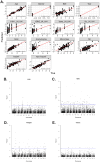This is a preprint.
The response to influenza vaccination is associated with DNA methylation-driven regulation of T cell innate antiviral pathways
- PMID: 38826189
- PMCID: PMC11142309
- DOI: 10.21203/rs.3.rs-4324518/v1
The response to influenza vaccination is associated with DNA methylation-driven regulation of T cell innate antiviral pathways
Update in
-
The response to influenza vaccination is associated with DNA methylation-driven regulation of T cell innate antiviral pathways.Clin Epigenetics. 2024 Aug 21;16(1):114. doi: 10.1186/s13148-024-01730-x. Clin Epigenetics. 2024. PMID: 39169387 Free PMC article.
Abstract
Background: The effect of vaccination on the epigenome remains poorly characterized. In previous research, we identified an association between seroprotection against influenza and DNA methylation at sites associated with the RIG-1 signaling pathway, which recognizes viral double-stranded RNA and leads to a type I interferon response. However, these studies did not fully account for confounding factors including age, gender, and BMI, along with changes in cell type composition.
Results: Here, we studied the influenza vaccine response in a longitudinal cohort vaccinated over two consecutive years (2019-2020 and 2020-2021), using peripheral blood mononuclear cells and a targeted DNA methylation approach. To address the effects of multiple factors on the epigenome, we designed a multivariate multiple regression model that included seroprotection levels as quantified by the hemagglutination-inhibition (HAI) assay test.
Conclusions: Our findings indicate that 179 methylation sites can be combined as potential signatures to predict seroprotection. These sites were not only enriched for genes involved in the regulation of the RIG-I signaling pathway, as found previously, but also enriched for other genes associated with innate immunity to viruses and the transcription factor binding sites of BRD4, which is known to impact T cell memory. We propose a model to suggest that the RIG-I pathway and BRD4 could potentially be modulated to improve immunization strategies.
Keywords: DNA methylation; RNA sequencing; cell-type deconvolution; influenza vaccine; influenza virus; targeted bisulfite sequencing.
Conflict of interest statement
Competing interests The authors declare that there are no competing interests.
Figures






Similar articles
-
The response to influenza vaccination is associated with DNA methylation-driven regulation of T cell innate antiviral pathways.Clin Epigenetics. 2024 Aug 21;16(1):114. doi: 10.1186/s13148-024-01730-x. Clin Epigenetics. 2024. PMID: 39169387 Free PMC article.
-
Longitudinal analysis of influenza vaccination implicates regulation of RIG-I signaling by DNA methylation.Sci Rep. 2024 Jan 17;14(1):1455. doi: 10.1038/s41598-024-51665-9. Sci Rep. 2024. PMID: 38228690 Free PMC article.
-
Activation of the RIG-I pathway during influenza vaccination enhances the germinal center reaction, promotes T follicular helper cell induction, and provides a dose-sparing effect and protective immunity.J Virol. 2014 Dec;88(24):13990-4001. doi: 10.1128/JVI.02273-14. Epub 2014 Sep 24. J Virol. 2014. PMID: 25253340 Free PMC article.
-
Nonsegmented Negative-Sense RNA Viruses Utilize N6-Methyladenosine (m6A) as a Common Strategy To Evade Host Innate Immunity.J Virol. 2021 Apr 12;95(9):e01939-20. doi: 10.1128/JVI.01939-20. Print 2021 Apr 12. J Virol. 2021. PMID: 33536170 Free PMC article.
-
Computationally inferred cell-type specific epigenome-wide DNA methylation analysis unveils distinct methylation patterns among immune cells for HIV infection in three cohorts.PLoS Pathog. 2024 Mar 11;20(3):e1012063. doi: 10.1371/journal.ppat.1012063. eCollection 2024 Mar. PLoS Pathog. 2024. PMID: 38466776 Free PMC article.
References
Publication types
Grants and funding
LinkOut - more resources
Full Text Sources
Molecular Biology Databases

